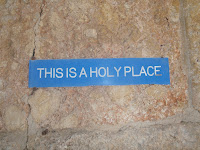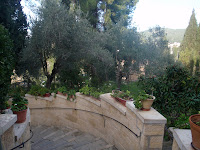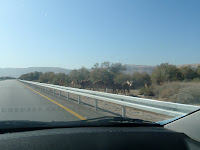
After an early night on Friday, Lee and I got up early on Saturday morning to drive down to Masada - the palace in the sky. Masada was listed by UNESCO as a world heritage site in 2001, which means it's cool. Super cool, in fact. (Sidenote: On the way down, we're cruising through the desert, when suddenly the car in front of us slams on their brakes, and we follow suit. Bounding across the road in front of us is a herd of Ibex! They just cruised on by and jumped up the hillside....Ibex! Wow!)

(sproing...sproing...sproing..)
Anyhow....
Sometime between 37BCE and 4BCE*, King Herod built a massive magnificent winter palace - which he never used - and this natural plateau/fortress was the last bastion of Jewish freedom fighters against the Romans (during the Second Temple). The assault ramp, camps, and assorted ruins are the most complete surviving Roman siege system in the world. I told you it was cool.
*BCE = BC, CE = AD.

(There were metal 'maps' in all the different areas on Masada. This is the northern palace)
So, I want to give you back story on this one, as it was so interesting. Herod built this huge palace with enormous cisterns scattered all over the grounds in order to keep water available - not only for drinking, but for ritual bathing, community swimming pools, and fountains. The cisterns were filled by a crazy intricate system of trenches built into the mountain, so pack animals that carried the water to fill them didn't have to go all the way to the top, necessarily. Ornately decorated, there were two palaces, a few bathhouses, enormous storerooms, dovecots, fields planted with crops of every type....it really was a self-sufficient city or township. The plateau was situated on two major trade routes, so it was perfectly located. And with obvious natural defenses, it was a prime location to hole up during a war.



(Inside the southern cistern; Water trench; Ruins of storehouses)
So, on to why it's super famous here. During the Great Revolt (Jews against Romans) in 66CE, there was a faction of zealots (called the Sicarii) who used this fortress to hide out from the dominating Roman forces. Not a lot of zealots, mind you- we're talking like under 1000 people (including women and children) who tucked themselves up and away on top of the plateau. The varied groups of settlers/rebels created a life on Masada for themselves- building ritual bathing houses, synagogues, and living in the casements and palaces conveniently built by Herod.
After the Romans conquered the rest of Judea, Masada was the last remaining Jewish stronghold. In 73 or 74 CE, the Roman Tenth Legion Fretensis (whatever that is) attacked Masada. With 8,000 troops, they built a siege wall, camps and an enormous ramp from the floor of the desert to the height of the plateau. (That is somewhere along the lines of 450 meters, folks, it was an incredible feat of determination to have made this thing.) After the siege had been going on for several months, they Romans brought a siege tower and battering ram up the ramp (!!!!). Finding the ram was ineffective against the reinforcing wood and earth walls the rebels had built, the Romans lit fire to the supports instead. With the favor of the wind, this tactic was going to work.

(The still-standing ramp)
Knowing that the Roman army would breach the fortress walls by dawn, 10 community leaders, rather than have their wives, children and neighbors raped/enslaved by the Romans, murdered the population of the stronghold. These 10 men then drew lots for who would kill the other nine and then commit suicide - suicide, of course, being a cardinal sin, and the loser would not be granted entrance to the hereafter. The very surprised Romans entered the city to find all but 7 inhabitants dead - the survivors were two women and five children who had hidden in cisterns to avoid death.
This was the last Judean holdout - the Romans then held all the land, and kept guards at Masada into the 2nd century.
So, wow, right? Crazy zealots.
Now the site is an active archeological site, which you can wander around in all day. To access the plateau, you can either walk up (eastern or western sides) or take a cable car. The walk on the eastern side is called the Snake path, and probably would take a good hour or two to ascend- it's steep and winding. The western side goes up along the siege ramp the Romans built oh-so-long ago, but to get to it, you have to drive from a town way in the middle of Israel. As we wanted as much time as possible on the site itself, Lee and I took the cable car up - and holy cow. The views are unbeatable. In fact the views from the entire site are unbeatable - you get a panoramic view of the entire area, and across the Dead Sea into Jordan.

(The Snake path, with our cable car shadow)
We wandered through the ruins, and noticed something interesting - they're rebuilding them. That's right- they're rebuilding an ancient world heritage site. And to show the difference between the 'new' walls and the old walls, they've painted this hideous black line all over the place! It's on nearly every wall at the northern palace, and at various other places around the ruins. It was distasteful and tacky - and unbelievable. Because they were doing this, it made it hard to discern what was actually built by Herod, what was modified by the rebels, and what was further modified by the Byzantine monks who took up residence after the Romans left. So, eyeballing everything with a cynic's eye, we spent nearly four hours wandering around on the plateau. There were some astounding things- the water cisterns were feats of genius, and the mosaics in the palaces were gorgeous - intricate, with many patterns and colors. And seeing the gigantic siege ramp - built of wood and earth - to the height it was built....incredible. The things that we believed to be remnants from the historic times were well worth seeing. And there aren't any warnings to stay back from the edges, or any high fences to keep you from falling off, or any real "don't walk here" zones- pretty much people are able to climb all over everything. I kinda liked that part, although it undoubtedly damages what's left of the actual ruins.


(Wow pretty...what is that ugly black line doing everywhere?? Lovely mosaic flooring)
....oh yeah, and during the summer, they do a sound and light show projected on the western wall of the plateau. The equipment litters the site at various spots. Talk about eyesore!
We headed back down the mountain in the cable car, and took off to see what else we could see. Unfortunately, Quamran (where the Dead Sea scrolls were found) closes at 5pm, and it takes 90 minutes to get up to the caves and back. As it was already past 4, we headed back to Jerusalem, driving past the beach where I had my float in the water, and past all the camels on the roadside, and into the hills. We had Petra scheduled for this coming weekend, but due to unforeseeable events, we'll probably postpone that for a while. As Lee's contract is being extended, we're not forced to cram everything that's left into the remaining three weeks, so there is time still to do it all.




































